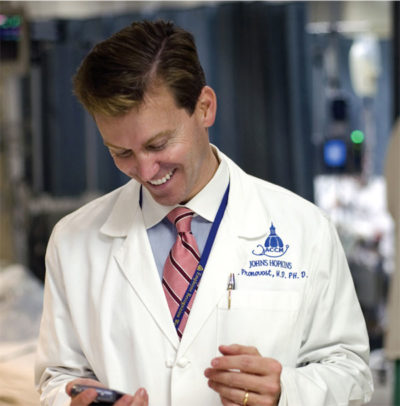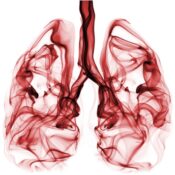“When Peter Pronovost was a fourth-year medical student at Johns Hopkins, he worked briefly in a mission hospital in Ogbomosho, Nigeria,” writes Eric Vohr, co-author of the new book and author of the November 2008 Post article “A checklist that’s saving lives”. “On any given day, hundreds of people linked up outside the clinic. While treating cases, he realized many problems—infections from bad water, burns from people carrying lighted oilcans on their heads to see at night—could have been prevented.”
Pronovost was no stranger to problems with the healthcare system. Before traveling to Nigeria, his father passed away from cancer that was misdiagnosed. By the time the correct diagnosis was made, it was too late for treatment.
“These and other experiences led me to believe that to improve health care, you have to affect policy,” says Pronovost. “That’s when I got the idea for the checklist.”

Pronovost tested his first checklist for medicine in 2001—a simple sheet of paper with five steps for doctors to follow in the intensive care unit at Johns Hopkins Hospital for a common but vital procedure, the placing of central venous catheters. The results were astounding: After 15 months, the hospital saved about two million dollars, prevented 43 infections and 8 deaths.
Today, the checklist program is saving lives (and billions of health care dollars) around the country and across the world.
Pronovost champions additional innovative patient safety initiatives in his new book: a federal program to help medicine learn from its mistakes, a systematic way to ensure valid measurement and accurate reporting of health care quality and safety, and creation of a government body devoted to patient safety research.
Here’s an excerpt from “Safe Patients, Smart Hospitals: How One Doctor’s Checklist Can Help Us Change Health Care From the Inside Out,” by Peter Pronovost, M.D., Ph.D., and Eric Vohr, released in February 2010.
I recently got two pieces of news that brought me back to the roots of my work. The first was that I was asked to give the commencement speech at Fairfield University, my alma mater. The second was that I learned my stepfather was dying of cancer.
My mother married her second husband, Paul, in September 2004. Three months after the wedding he was diagnosed with colon cancer.
My father’s death, also from cancer, was one of the motivating factors that propelled me toward pursuing medicine and patient safety as a career. The fact that I was soon to lose a second father to cancer, and that I was scheduled to return to the campus where I first learned of my father’s illness, stirred up a lot of emotion and memories.
I needed to think, and the best way for me to sort out my thoughts was to run. So I put on my running shoes and headed out the door. As I got into the zone, I thought about how my team and I had successfully conducted the largest valid quality improvement project in Michigan, which is now being implanted across the country. We helped to elevate patient safety as a respected science, we matured that science and began saving thousands of lives and millions of dollars. We have informed practice and health policy. We partnered with WHO and are implementing the program in several countries. We have trained medical and nursing students, residents, and attending physicians in the science of safety. We have helped improve teamwork and communication between doctors and nurses and helped restore joy to the practice of medicine.
I wanted to tell the graduates of Fairfield about our work in patient safety and what we had accomplished and were accomplishing. But a talk based solely on our achievements in medicine would most likely bore them to death. I needed a way to connect our work to the challenges they would face in the coming years.
Suddenly, I knew what I wanted to say—now I had to return to my house and put it down on paper.
The university kindly arranged to get a driver to take me from Baltimore to Fairfield. I felt a sense of great illumination in returning to this place, where so many early impressions and experiences shaped who I am today. As I walked on stage in front of a crowd of more than fifteen thousand students, parents, alumni, and families, that feeling only intensified.
I started my speech like so many others. I thanked the university for inviting me and congratulated the graduates and their parents. I told them about my life as a student at Fairfield and how my brothers, my father, and my uncle had all graduated from the school. I talked about the challenges they would face in the coming years and how it was their duty to lead the way into the future. I explained the work I had done at Hopkins and in Michigan and how we were spreading that work across the globe. I shared with them how this had become my mission, my goal, and how I believed each of them would find a way to do their small art in making this world a better place. And then I told them about Josie.
I felt a familiar lump in my throat, the same tragic sorrow I had felt when I first talked about Josie with her parents Sorrel and Tony. I had told this simple story hundreds of times in hundreds of different settings and it always touched me deeply. I was sure it would have the same effect here.
An adorable eighteen-month-old girl, Josie King, who was hauntingly similar to my daughter, Emma, died of preventable mistakes; principal among them was a catheter infection.
On the four-year anniversary of her death, her mother asked if Josie would be less likely to die today than four years ago. I started tell her all the stuff we were doing at Hopkins. She abruptly and appropriately cut me off; she did not want to know what we were doing she wanted to know whether Josie would be less likely to die. She wanted to know whether patients were safer; she wanted results. At the time, neither I nor Hopkins nor the U.S. health system could give her an answer. I believe she deserves one . . . Many thought we were too bold and doomed to failure. Others thought we were native or downright nuts. There were too many obstacles; the resources were insufficient. When faced with challenges, many are blinded by obstacles and never start on the journey. Others see the endgame and the obstacles as something to be climbed or avoided. We focused on the endgame. We focused on the Josie Kings of the world.
Read more about Dr. Pronovost’s groundbreaking work as featured in the November 2008 Post article, “A Checklist That’s Saving Lives” by Eric Vohr.
Become a Saturday Evening Post member and enjoy unlimited access. Subscribe now



